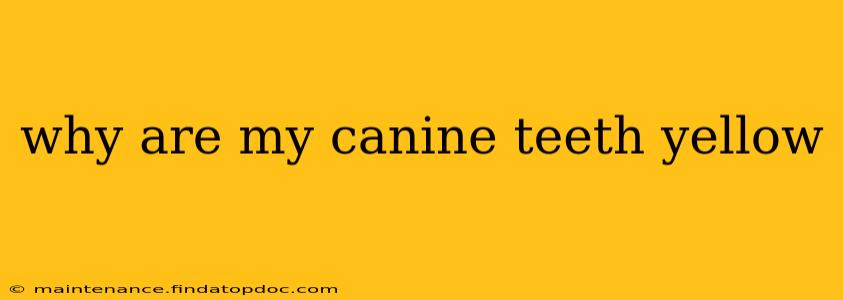Why Are My Canine Teeth Yellow? Unmasking the Causes of Discolored Canines
Yellowing canine teeth, those prominent pointy teeth at the front of your mouth, can be a source of concern. While a slight yellowing might be perfectly normal, significant discoloration warrants attention. Understanding the underlying causes is the first step towards addressing the issue and restoring a brighter smile. This comprehensive guide delves into the various reasons why your canine teeth might be yellow, offering insights and solutions.
What Causes Yellow Teeth in General? (And How Does This Apply to Canines?)
Before focusing specifically on canine teeth, it's crucial to understand the general causes of yellow teeth. The enamel, the outermost layer of your teeth, is naturally slightly translucent, allowing the underlying dentin (a yellowish layer) to show through. Over time, this dentin becomes more visible, leading to yellowing. Several factors accelerate this process:
- Age: As we age, enamel thins, making the yellow dentin more prominent. This affects all teeth, including canines.
- Diet: Foods and drinks like coffee, tea, red wine, and berries contain chromogens—pigments that stain teeth. These stains can accumulate more readily on the more exposed surfaces of canine teeth due to their position.
- Smoking: Nicotine and tar in tobacco products are potent stain-causing agents, significantly impacting the color of all teeth, including the canines.
- Poor Oral Hygiene: Insufficient brushing and flossing allow plaque and tartar to build up, staining teeth and contributing to discoloration. This is especially true around the gumline, where canines often meet the gum tissue.
- Medications: Certain medications, like tetracycline antibiotics taken during tooth development, can cause intrinsic staining—discoloration from within the tooth structure itself. This can affect canines along with other teeth.
- Trauma: An injury to a canine tooth can sometimes lead to discoloration, often appearing darker or yellower than other teeth.
- Genetics: Some people are simply predisposed to yellower teeth than others due to their natural enamel thickness and dentin color.
Why Are My Canine Teeth Yellow Compared to My Other Teeth?
This is a frequently asked question, and the answer often lies in the combination of factors mentioned above. Canine teeth are often more prominently positioned and slightly more exposed than other teeth, making them more susceptible to staining from food, drinks, and smoking. They also sometimes experience more wear and tear due to their prominent location.
Can I Whiten Yellow Canine Teeth at Home?
Many at-home whitening options exist, including whitening toothpastes, strips, and trays. However, it's essential to consult a dentist before embarking on any teeth whitening regimen. They can assess the cause of the discoloration and recommend the safest and most effective approach. Over-the-counter products may not be suitable for all types of discoloration, and improper use could damage your enamel.
When Should I See a Dentist About Yellow Canine Teeth?
While some yellowing is normal, you should consult a dentist if:
- The yellowing is significant and sudden.
- You experience sensitivity or pain in your canine teeth.
- You notice any changes in the texture or shape of your canine teeth.
- Your yellowing seems localized to only your canine teeth, rather than a general yellowing of the teeth.
Are There Different Types of Yellowing in Canine Teeth?
Yes, discoloration can be extrinsic (on the surface) or intrinsic (within the tooth). Extrinsic staining is usually easier to treat with professional or at-home whitening methods. Intrinsic staining, however, often requires more advanced treatments like veneers or bonding. A dentist can determine the type of staining present in your canine teeth.
How Can I Prevent My Canine Teeth From Yellowing?
Maintaining good oral hygiene is crucial. This involves:
- Brushing twice daily with fluoride toothpaste.
- Flossing daily.
- Visiting your dentist regularly for checkups and professional cleanings.
- Limiting consumption of staining foods and drinks.
- Quitting smoking.
By following these guidelines and seeking professional dental advice when necessary, you can significantly reduce the risk of yellowing canine teeth and maintain a healthy, bright smile. Remember, consulting a dentist is vital for accurate diagnosis and personalized treatment.
